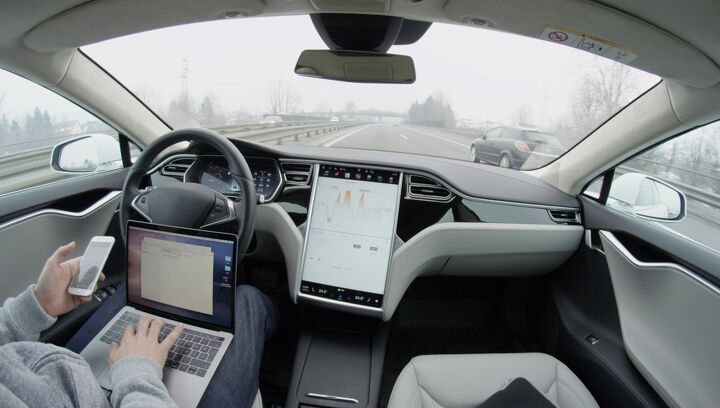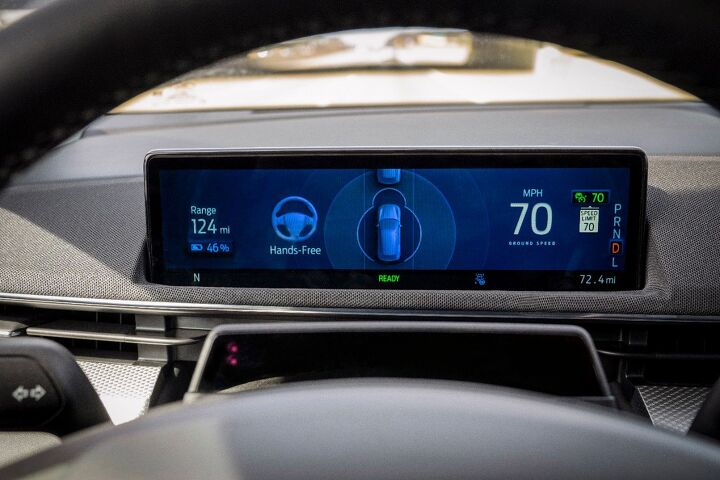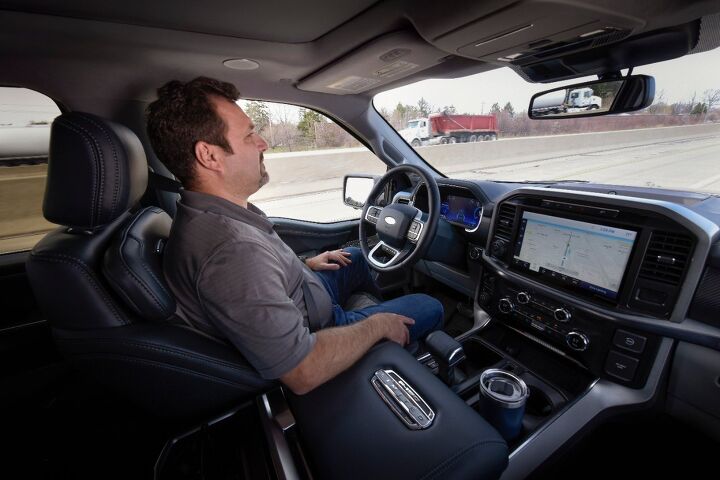#AdvancedDrivingAids
Opinion: Tesla's Full-Self Driving Beta Is a Bad Joke
Earlier this week, Elon Musk announced that Tesla would begin offering the Full Self-Driving (FSD) Beta to testers that had achieved sufficiently high marks in its new “safety score.” While company has repeatedly promised to launch FSD in earnest, which costs $10,000 to purchase or $199 a month to rent (depending on which version of Autopilot you’re using), the system has been habitually delayed from getting a widespread release. This has upset more than a few customers operating under the assumption that having bought into the service actually meant something.
That said, the rollout has technically begun and continues encompassing more users. But regulators are annoyed that the company is now testing FSD’s functionality on thousands of paying customers and the terms in which Tesla is offering FSD has changed in a manner that makes your author extremely uncomfortable. The automaker originally intended to provide the system via a simple over-the-air (OTA) update as availability expanded. However Tesla now has a button allowing drivers to request FSD by opening them up to a period of scrutiny where their driving is digitally judged. Despite your having already shelled out cash for it, access to the beta is determined by the manufacturer’s safety score.
Twist: NHTSA Tesla Autopilot Probe Now Includes Other Automakers
The National Highway Traffic Safety Administration (NHTSA) has been doing a deep dive into Tesla’s Autopilot to determine if 765,000 vehicles from the 2014 model year onward are fit to be on the road. We’ve covered it on numerous occasions, with your author often making a plea for regulators not to harp on one company when the entire industry has been slinging advanced driving aids and distracting infotainment displays for years.
Apparently someone at the NHTSA either heard the blathering, or was at least of a similar mind, because the organization has expanded its investigation to include roughly a dozen other automakers.
NHTSA Identifies 12th Autopilot Related Crash Involving Emergency Vehicles
The U.S. National Highway Traffic Safety Administration (NHTSA) has identified another traffic incident pertaining to Tesla’s driver assistance features and emergency vehicles, making the current tally twelve. These wrecks have been a matter of focus for the agency ever since it opened a probe to determine whether or not Autopilot can handle hiccups in the road caused by scenes where flares, cones, disabled automobiles, and first responders coalesce.
Though concerns remain that Tesla is being singled out unjustly when there’s little evidence to suggest that other manufacturers are providing more capable systems. Tesla’s issues appear to be heavily influenced by irresponsible marketing that makes it seem as though its vehicles are self-driving when no manufacturer can make that claim. U.S. regulators now want to place more restrictions on vehicles boasting autonomous features and, thus far, Tesla has been behind on those trends. But it’s hard to support claims that they make vehicles safer when none seem as effective as they should be.
Driving Dystopia: Tesla Activates Driver Monitoring Protocols
There’s a small camera just above the rear-view mirrors installed in newer Tesla models. If you haven’t noticed it before, it wasn’t of any particular relevance. But it certainly is now.
Tesla has decided to activate driver monitoring protocols in an effort to avoid liabilities whenever Autopilot fails and motorists unexpectedly find themselves merging off a bridge. After rummaging through the wreckage and collecting errant body parts, investigators can use the vehicle’s camera data to see what was happening moments before the car hurled itself into the ravine. If it turns out that the driver was totally alert and did their utmost to wrangle the vehicle as it went haywire, a colossal payout for the surviving family is assured. But if that camera catches them slipping for a microsecond, the manufacturer has all it needs to shift the blame onto the deceased driver.
Stuck in Reverse? Tesla Abandons Radar, Restricts Features
Tesla is abandoning radar on its more affordable vehicles so it can deploy something that sounds like a vintage color motion picture process where the hues really manage to jump off the screen.
“ Tesla Vision” is the current process the company will use to collect and interpret the information necessary to operate semi-automated systems on the Model 3 and Model Y. But it feels like a step backward, if we’re being honest, and will result in cars that have “temporarily limited” abilities.
Auto Lobby Now Recommends Driver Monitoring Cameras
On Tuesday, the largest automotive lobbying group released a handful of safety guidelines related to driver monitoring for vehicles equipped with driver-assistance features. It’s pageantry designed to convince you and the rest of the world to embrace technologies that have already led to unsettling privacy violations. The Alliance for Automotive Innovation making recommendations for the industry is farcical because the AAI already represents just about every major player on the field, suppliers included. The only real outsider is Tesla, which the organization decided would make an excellent scapegoat for the broader tech agenda.
But there’s still merit to the discussion, especially if the only proposed solution is to let the industry watch us inside our cars 24/7.
Ford Introduces 'Hands-Free' BlueCruise System for F-150, Mach-E
On Wednesday, Ford Motor Co. announced its upcoming hands-free driver-assist system intended to rival Tesla’s Autopilot or General Motors SuperCruise. The service, which the manufacturer has renamed BlueCruise, will be available on top trimmed “Mustang” Mach-E crossovers and F-150 pickup trucks via over-the-air-updates in the third quarter of 2021.
It will not be free, however.
Even though Ford has promised highly competitive pricing, customers will need to have purchased vehicles equipped with the necessary hardware (including driver monitoring cameras) before they’ll be eligible to spend the additional $600 Ford is asking for the privilege of using BlueCruise for three years. While more affordable than the competition, it still seems a lot to spend on a vehicle so you can pretend it’s self-driving – especially since the company failed to make it sound like it would be any more advanced than what’s being offered on Tesla and Cadillac vehicles that similarly cannot drive themselves.
GMC Plotting Super Cruise for Sierra Denali
On Wednesday, General Motors announced plans to launch a version of Super Cruise on the 2022 GMC Sierra Denali modified to work with trailers. The hands-free driver assistance system (GM can’t call it “autonomous” because it technically isn’t) will stop being exclusive to Cadillac products and branch out into premium offerings from GMC and Chevrolet’s Bolt EV.
While unavailable until late in 2021, the next round of vehicles to be equipped with Super Cruise is supposed to see continued improvements to the system that allow for greater coverage. When the system originally launched on the Cadillac CT6 sedan, it was only eligible for use on specific divided highways for safety reasons. The greater emphasis on avoiding accidents was appreciated but it made the system seem more like a flashy gimmick than something any serious person would use on the regular. But GM has taken great strides to make sure that didn’t remain the case — hence the new trailer capabilities and ever-widening operating area.
IIHS Study Underlines the Perils of Driver Disengagement
It turns out there’s a name for the false sense of security provided by modern driving aids. According to researchers with the Insurance Institute for Highway Safety (IIHS) and the Massachusetts Institute of Technology’s AgeLab, the phenomenon is called “driver disengagement” and it’s assumed to be a contributing factor to roadways fatalities. The duo recently published a rather basic study examining how evolving automotive technologies might be eroding safety under the guise of progress.
Since we’ve been onto the perils and shortcomings of advanced driving aids since their introduction, it also provides us with another stellar opportunity to gloat. Heck, our criticisms go back far enough to predate any reputable research on the matter. We were just bitter cranks then, annoyed that the systems seemed unworthy of our trust despite constantly demanding it. But the IIHS said its latest testing found motorists frequently lose focus while utilizing features like adaptive cruise control and lane-keeping. This issue reportedly worsens the more familiar drivers become with the systems, which would be fine if they could be counted on for total effectiveness. Sadly, there’s been more than enough testing for us to know that’s not the case.
Motorcycles Set to Embrace Electronic Nannies, Thanks Ducati
On Tuesday, Ducati announced it would be adding adaptive cruise control and blind-spot monitoring to the Multistrada V4 — effectively making it the first production motorcycle in the world to receive such features. While chucking front and rear-facing radar onto an automobile has become relatively common, motorbikes haven’t been getting them. Pricing remains the largest concern but many motorcycle enthusiasts have also pointed out the systems may expose riders to unnecessary risks.
If the forward-mounted radar on your car sees the vehicle in front getting closer, it may jam on the brakes to save you from an accident. On two wheels, that same action runs the risk of tossing a rider over the handlebars before promptly running themselves over. This leaves us wondering as to the true usefulness of these systems migrating to motorcycles. Have we gone mad with electronic nannies or is all this progress worth it to keep us safe?
J.D. Power Reveals What Owners Find Annoying About Automotive Technology
Today’s automobiles are loaded with the kind of technology our grandparents could only dream about. Unfortunately, some dreams aren’t all they’re cracked up to be, and we’ve often bemoaned the many annoyances associated with modern vehicles.
J.D. Power recently shared its Tech Experience Index (TXI) Study, which has been modified to better assess specific features American drivers did and did not enjoy. The general takeaway seems to be that the average motorist feels pretty good about outward-facing cameras and anything else that improves a car’s outward visibility (handy in an era of extra chubby structural pillars).
However, the more intrusive safety inclusions that actively modify how the vehicle responds to the world around it didn’t seem to get nearly as much love, with many respondents suggesting they don’t trust the systems to behave in a predictable manner. It’s something we’re in broad agreement with and echoes many of the complaints we’ve heard from readers, friends, or rattling within our own skulls.
Center for Auto Safety Asks Nissan to Brake Check Itself
Advanced driving aids have been slighted once again. This time, the Center for Auto Safety is asking Nissan to issue a safety recall on several models it believes have received too many customer complaints about their automatic emergency braking systems.
It also claims the manufacturer is already aware of the situation, after filing an public-information requests that showed Nissan being in possession of more than 1,400 complaints and field reports alleging the systems are activating when they shouldn’t. The company is also on the receiving end of some lawsuits over the matter.
We’d hate to harp on Nissan more than necessary. The manufacturer already has a laundry list of problems it’s hoping to solve, and there’s clear evidence that advanced driving aids are acting goofy across the board — especially as they become more commonplace. Last week, we reported on another AAA assessment encompassing multiple brands that once again showed just how reliable these electronic nannies aren’t.
Are Modern Driving Assistance Features Unreliable? AAA Researchers Say Yes
The American Automobile Association (AAA) is recommending automakers limit the use of advanced driving aids after concluding they’re not really up to the challenge of providing reliable safety.
Over the past two years, AAA has focused on testing crash prevention systems to see if they’re all manufacturers claim — deciding that while many are useful in some instances, they’re far too inconsistent to be considered reliable safety nets. Like us, the group worries that making these features commonplace has created a false sense of security among drivers. While one might assume advanced driving aids have to be halfway decent to be put into vehicles, AAA’s pedestrian detection test from 2019 showed they’re anything but consistent.
On Thursday, America’s favorite motor club returned to report on its latest findings on five systems currently offered by the industry. For the test, AAA selected a 2019 BMW X7 with Active Driving Assistant Professional, 2019 Cadillac CT6 with Super Cruise, 2019 Ford Edge with Co-Pilot360, 2020 Kia Telluride with Highway Driving Assist, and a 2020 Subaru Outback with EyeSight. The group was sent to numerous testing sites in California, Utah, and Nevada, and given a 4,000-mile shakedown on public roads — where the outfit found the systems averaged a misstep or disengagement roughly every 8 miles.
The Hero We Need: Consumer Access to Repair Coalition
When it comes to activism, it’s best to choose your battles carefully. Fortunately, there aren’t too many causes within the auto industry and most are easy to get behind.
Even though environmental activists sometimes find themselves at odds with reality, their hearts are usually the right place, and they’ve encouraged automakers to try new and interesting things with transportation. Safety advocates can likewise go overboard, but we wouldn’t have seen cars get dramatically safer (or heavier) since the 1970s if they hadn’t.
Our favorite has to be consumer advocacy, however. With the exception of the occasional predatory lawsuit looking to take advantage of a dumb corporate decision, there’s precious little to scoff about. It also tends to overlap with our pet peeves by decrying bad business practices within the industry. Case in point, the Consumer Access to Repair Coalition has recently asked Congress to rethink how vehicular data is shared — noting that automakers shouldn’t need real-time monitoring for repairs and that the technology likely poses an unnecessary security risk.
Annoy the Driver: IIHS Offers Its Two Cents on Improving Self-Driving Safety
The Insurance Institute for Highway Safety (IIHS) has issued a set of guidelines for advanced driving aids, suggesting that the key to automated safety is making sure drivers are perpetually engaged with the vehicle’s operations. Unfortunately, this has turned out to be a Catch-22 scenario due to the way these systems function. Semi-autonomous features are supposed to be there to help promote safety by adding an extra layer of protection; however, many encourage motorists to disengage by nature of their design.
Adaptive cruise control with lane keeping is probably the worst offender. Implemented as a way to keep cars a safe distance apart on the expressway, it offers an experience that borders on having the car chauffeur you around. The effectiveness of these systems vary widely, with none actually being capable of any legitimate self-driving functionality. You’re also not supposed to be able to tune out while they’re in use, but they all seem coyly contrived to do exactly that. The IIHS is concerned this phenomenon will only get worse as driving aids evolve and become increasingly commonplace.
“Unfortunately, the more sophisticated and reliable automation becomes, the more difficult it is for drivers to stay focused on what the vehicle is doing,” said IIHS President David Harkey. “That’s why systems should be designed to keep drivers actively engaged.”




























Recent Comments